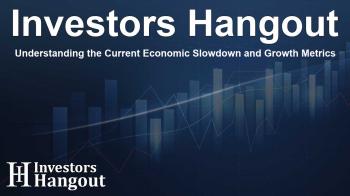Understanding the Current Economic Slowdown and Growth Metrics

Current Economic Landscape
The economic narrative continues to unfold as analysts scrutinize various indicators and metrics that shape our understanding of growth. Notably, the GDP figures recently released have sparked considerable discussion. While the overarching sentiment might lean towards optimism, a closer examination reveals subtle deceleration in core growth metrics, which warrants thoughtful consideration.
Quarterly Growth Indicators
Recent insights into quarterly indicators reveal nuanced shifts in the trajectory of GDP, particularly in relation to expected trends. Although a reported growth of 3% in GDP exceeded most predictions, it's crucial to note that this growth does not necessarily align with the previous upward trajectory experienced prior to certain economic policies. The day before these results were released, projections from the Atlanta Fed indicated a closely aligned estimate of 2.9%, underscoring the accuracy of economic forecasting methodologies.
To gain a clearer perspective, it’s beneficial to utilize core GDP metrics. This measurement strips out volatile components such as inventory levels and focuses solely on final sales to private domestic purchasers. This underlying metric serves as a beacon to gauge genuine economic momentum and demand, providing a broader context beyond the headline GDP figure.
Core GDP Insights
Analysis of core GDP metrics indicates that while private domestic purchases appear to have surprised on the upside, they are still showing signs of deceleration. The annualized growth rate stands at 1.8%, which, although positive, falls short of earlier estimates. This trend highlights the need for a comprehensive view of economic activity that transcends surface-level measurements.
Monthly Economic Indicators Analysis
Shifting focus to monthly indicators, the latest releases have included vital data on consumption, personal income, and manufacturing sales. These indicators collectively paint a picture of current economic health and potential shifts in the labor market. Despite existing expectations for nonfarm payroll growth, recent trends indicate stagnation in employment numbers, with personal consumption exhibiting flat performance.
The Implication of Personal Income Data
As we contemplate the implications of personal income data, it's important to recognize that this metric holds significant weight in understanding consumer behavior. With fluctuations in income affecting spending patterns, the data suggests a tempered outlook for the retail sector. Additionally, the manufacturing industry has been exhibiting downward trends, indicating potential challenges ahead.
Looking Toward the Future
As we analyze cumulative data from both monthly and quarterly indicators, it becomes increasingly challenging to detect signs of imminent recession. While some indicators suggest a softening in growth, the consensus highlights that the economy is entering a phase of deceleration rather than contraction. It's essential for analysts and investors alike to remain vigilant, as ongoing revisions to economic data can alter the prevailing narrative.
In the coming months, understanding the evolving landscape will require a multifaceted approach that takes into account both headline figures and underlying metrics. This approach will provide a more balanced perspective on the economy's trajectory, enabling stakeholders to make informed decisions amidst the changing climate.
Frequently Asked Questions
What is the significance of the GDP figure?
The GDP figure serves as a broad indicator of economic health, reflecting the total value of goods and services produced. It helps gauge the economy's overall performance.
How does Core GDP differ from traditional GDP?
Core GDP excludes volatile components such as inventory changes and focuses solely on private consumption, providing a clearer picture of underlying economic momentum.
What do current trends in personal income indicate?
Current trends suggest stagnation in personal income growth, which can impact consumer spending and overall economic demand.
Are we heading toward a recession?
While signs of economic slowdown are evident, current data does not strongly indicate an imminent recession. Instead, growth appears to be decelerating.
What factors should investors watch moving forward?
Investors should monitor GDP trends, consumer spending, personal income, and employment figures as they will provide critical insights into economic conditions.
About The Author
Contact Evelyn Baker privately here. Or send an email with ATTN: Evelyn Baker as the subject to contact@investorshangout.com.
About Investors Hangout
Investors Hangout is a leading online stock forum for financial discussion and learning, offering a wide range of free tools and resources. It draws in traders of all levels, who exchange market knowledge, investigate trading tactics, and keep an eye on industry developments in real time. Featuring financial articles, stock message boards, quotes, charts, company profiles, and live news updates. Through cooperative learning and a wealth of informational resources, it helps users from novices creating their first portfolios to experts honing their techniques. Join Investors Hangout today: https://investorshangout.com/
The content of this article is based on factual, publicly available information and does not represent legal, financial, or investment advice. Investors Hangout does not offer financial advice, and the author is not a licensed financial advisor. Consult a qualified advisor before making any financial or investment decisions based on this article. This article should not be considered advice to purchase, sell, or hold any securities or other investments. If any of the material provided here is inaccurate, please contact us for corrections.

